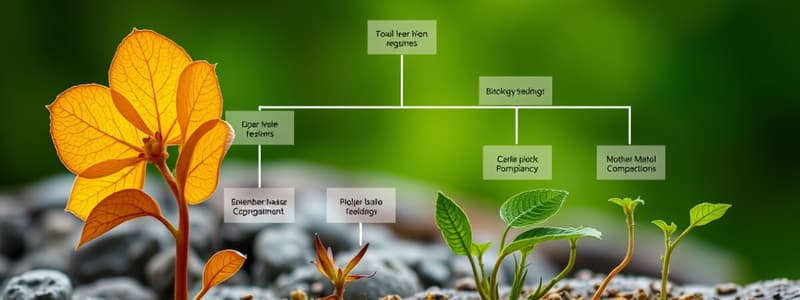Podcast
Questions and Answers
What is the smallest structural and functional unit of an organism?
What is the smallest structural and functional unit of an organism?
- Cell (correct)
- Tissue
- Molecule
- Organ
Which level of biological organization consists of groups of interbreeding organisms?
Which level of biological organization consists of groups of interbreeding organisms?
- Population
- Species (correct)
- Ecosystem
- Community
What is the ultimate source of energy for life on Earth?
What is the ultimate source of energy for life on Earth?
- The sun (correct)
- Water
- Wind
- Geothermal heat
Which of the following best describes metabolism?
Which of the following best describes metabolism?
What is an organism composed of?
What is an organism composed of?
In biological organization, what is a community?
In biological organization, what is a community?
Which level of biological organization describes the physical environment interacting with populations?
Which level of biological organization describes the physical environment interacting with populations?
What is a primary source of nutrients for humans?
What is a primary source of nutrients for humans?
Which kingdom of the domain Eukarya primarily consists of organisms that perform photosynthesis?
Which kingdom of the domain Eukarya primarily consists of organisms that perform photosynthesis?
Which of the following organisms is classified as a vertebrate?
Which of the following organisms is classified as a vertebrate?
What characteristic distinguishes mammals from other vertebrates?
What characteristic distinguishes mammals from other vertebrates?
Which of the following kingdoms includes organisms primarily known as invertebrates?
Which of the following kingdoms includes organisms primarily known as invertebrates?
Humans belong to which kingdom under the domain Eukarya?
Humans belong to which kingdom under the domain Eukarya?
Which group of eukaryotes is known for their diverse modes of nutrition including absorption of nutrients?
Which group of eukaryotes is known for their diverse modes of nutrition including absorption of nutrients?
Which of the following is NOT a characteristic of vertebrates?
Which of the following is NOT a characteristic of vertebrates?
Which kingdom includes organisms that are often single-celled or multicellular and primarily live in aquatic or moist environments?
Which kingdom includes organisms that are often single-celled or multicellular and primarily live in aquatic or moist environments?
What is the primary role of sugars in the food chain?
What is the primary role of sugars in the food chain?
What is homeostasis?
What is homeostasis?
What occurs during the development of an organism?
What occurs during the development of an organism?
How can mutations be beneficial in the context of evolution?
How can mutations be beneficial in the context of evolution?
What is the mechanism by which evolution occurs?
What is the mechanism by which evolution occurs?
Which of the following is a characteristic that distinguishes Eukarya from Bacteria and Archaea?
Which of the following is a characteristic that distinguishes Eukarya from Bacteria and Archaea?
What is an adaptation in the context of evolutionary biology?
What is an adaptation in the context of evolutionary biology?
Which domains of life contain prokaryotes?
Which domains of life contain prokaryotes?
What distinguishes humans from apes?
What distinguishes humans from apes?
In which domain do humans belong?
In which domain do humans belong?
What is the first step in the scientific method?
What is the first step in the scientific method?
Which statement best describes a hypothesis?
Which statement best describes a hypothesis?
What role do test groups serve in an experiment?
What role do test groups serve in an experiment?
What is an essential characteristic of the independent variable in an experiment?
What is an essential characteristic of the independent variable in an experiment?
Which step follows analyzing data/results in the scientific method?
Which step follows analyzing data/results in the scientific method?
What is the purpose of background research in the scientific method?
What is the purpose of background research in the scientific method?
What is the primary purpose of analyzing data in scientific experiments?
What is the primary purpose of analyzing data in scientific experiments?
In a double-blind study, which of the following statements is true?
In a double-blind study, which of the following statements is true?
What role do graphs play in data presentation?
What role do graphs play in data presentation?
Why is a controlled group important in an experiment?
Why is a controlled group important in an experiment?
How can the conclusion of one experiment influence future studies?
How can the conclusion of one experiment influence future studies?
Flashcards are hidden until you start studying
Study Notes
Learning Outcomes
- Understand characteristics shared by all living organisms.
- Identify levels of biological organization and classification.
- Grasp the general scientific method process.
Levels of Biological Organization
- Organized from atoms to molecules.
- Cells: smallest structural and functional units; can be unicellular or multicellular.
- Tissues: groups of similar cells serving specific functions.
- Organs: composed of several tissue types working together.
- Organ systems: groups of organs collaborating for common purposes.
- Organism: collection of organ systems.
- Species: interbreeding organisms.
- Population: members of a species in a defined area.
- Community: interactions among different populations.
- Ecosystem: communities interacting with physical environments.
- Biosphere: all of Earth's ecosystems.
Energy and Metabolism
- Energy: capacity to perform work; essential for human survival.
- Nutrients from food are critical for body functions and energy.
- Metabolism encompasses chemical reactions within cells; utilizes solar energy via photosynthesis in plants and some bacteria.
Homeostasis
- Homeostasis refers to maintaining a stable internal environment.
- Organ systems maintain homeostasis by responding to both internal and external stimuli.
Reproduction and Development
- Reproduction transmits genetic information across generations.
- Growth refers to increases in size and cell number, while development includes all life changes from fertilization to death.
- DNA contains hereditary information and specifies traits through genes, with mutations potentially leading to evolution.
Evolutionary Concepts
- Evolution: population changes over time through natural selection.
- Natural selection occurs when advantageous traits enhance resource acquisition and reproductive success.
Classification of Life
- Life is divided into three domains: Bacteria, Archaea, and Eukarya.
- Bacteria and Archaea are prokaryotic; Eukarya includes organisms with eukaryotic cells, some unicellular and others multicellular.
Kingdoms within Eukarya
- The domain Eukarya is categorized into four kingdoms:
- Plantae (plants)
- Fungi (fungi)
- Animalia (animals)
- Protista (protists)
Characteristics of Kingdom Animalia
- Most Animalia members are invertebrates; vertebrates possess a nerve cord protected by a vertebral column.
- Mammals are a subset of vertebrates characterized by hair or fur and mammary glands.
Human Distinction
- Humans share a common ancestor with apes, notable for advanced brain development, upright posture, complex language, and diverse tool use.
The Scientific Method
- A structured approach to problem-solving involves making observations, forming hypotheses, conducting experiments, analyzing results, and drawing conclusions.
- Steps include:
- Observations
- Background research
- Hypothesis formulation
- Experiment execution
- Data analysis
- Conclusion reporting
Hypotheses and Testing
- A hypothesis is a testable explanation for observations.
- Scientific predictions are based on hypotheses and require a careful experimental design with control and test groups.
Data Analysis
- Experimental results are presented in various formats, such as graphs and statistics, to summarize findings and identify trends.
Controlled Studies
- Controlled studies compare a treatment group with a control group receiving a placebo, often using double-blind designs to eliminate bias.
Importance of Controlled Studies
- Provides rigorous testing of hypotheses by minimizing variables and enhancing reliability of results.
Studying That Suits You
Use AI to generate personalized quizzes and flashcards to suit your learning preferences.



